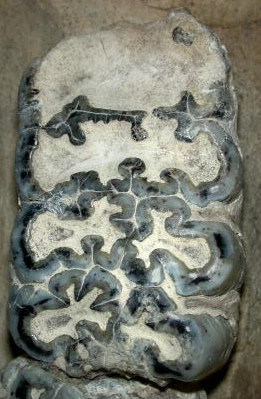Class Mammalia
Order Proboscidea
Family Gomphotheriidae
Cuvieronius tropicus—Cuvier's Gomphothere // Rhynchotherium sp.—Snouted Gomphothere // Stegomastodon mirificus—Wonderful Stegodont
 Gomphotheres share the general proboscidean characters. Their dentition is
more complex than that of the mastodon and less than that of the mammoths. The cheek
teeth are relatively low crowned, but cusps and accessory cusps add complexity such
that wear produces trefoils (Kurtén and Anderson 1980), the lobes of which may
be further subdivided (Fig. 1).
Gomphotheres share the general proboscidean characters. Their dentition is
more complex than that of the mastodon and less than that of the mammoths. The cheek
teeth are relatively low crowned, but cusps and accessory cusps add complexity such
that wear produces trefoils (Kurtén and Anderson 1980), the lobes of which may
be further subdivided (Fig. 1).
Fig 1. Upper left second molar of Stegomastodon mirificus, anterior to the top. The anterior of the tooth is heavily worn, with decreasing wear posteriorly. The dark gray and black is enamel; the light gray inside the bands of enamel is dentine. The crown of the unworn tooth was covered with enamel, the dentine now showing only where the enamel has been worn away. Light gray on the sides of the tooth and running between the major lophs is cementum. The trefoil pattern shows up well on the third loph, though the left subdivision of the loph shows additional complexities.
In general, herbivores that have low-crowned, simple teeth are typically browsers. With increasing harshness of foodstuffs, the teeth tend to become more complex. This serves two functions: increased complexity of the extremely hard enamel means that there is more of this slow-wearing material to contact the food and the opposing tooth, thus retarding wear (wearing out teeth and thus starving before completion of reproduction is an effective contraceptive; under such regimes, natural selection tends to favor individuals whose genetics produce more complex teeth). Increased enamel complexity also increases the area of linear enamel ridges caused by slower wearing of the enamel compared to the softer dentine; these ridges localize the intense pressure generated during chewing, efficiently reducing the plant parts. We can thus hypothesize that gomphotheres likely included a fair amount of harsh vegetation or, perhaps, open and somewhat sparsely vegetated areas where abrasive dust chronically coated their plant food.
The gomphotheres need revision. However, as far as known, only two species made it into the Irvingtonian in our region, and neither survived that land-mammal age (Morgan and Lucas 2005). Survival was later in Florida and very late in South America (Kurtén and Anderson 1980).
Literature. Kurtén and Anderson 1980; Morgan and Lucas 2005.
Last Update: 27 Jun 2014